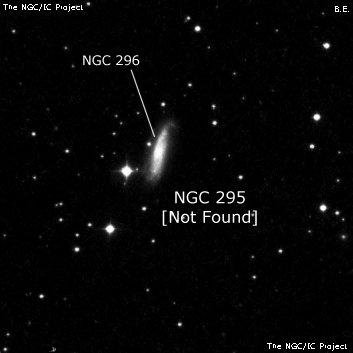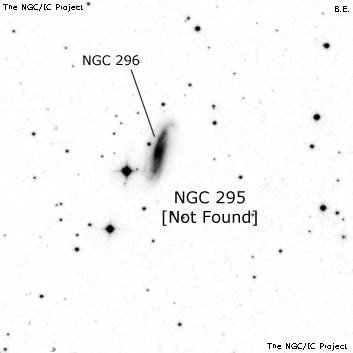NGC/IC Project Restoration Effort
(This is a very very beta version)
NGC295


Basic Information
Location and Magnitude
Right Ascension: 0:55:5.0
Declination: +31:31:48
Constellation: PSC
Visual Magnitude:
Historic Information
Discoverer: Copeland
Year of discovery: 1872
Discovery aperture: 72.0
Observational
Summary description: F, S, R, * 10" n, II 214 nf
Sub-type: NF
Corwin's Notes
=====
NGC 295 is no longer lost, thanks to Yann Pothier. By way of background, here
is what I had to say about it earlier.
This object was found by Copeland with LdR's 72-inch reflector while he was
examining what he thought was NGC 296. His description of the field is
precise: "[NGC 296] F, R, *10m (yellow) Pos 29.6 deg, Dist 123.1 arcsec.
Nova [NGC 295], S, R, and with a * or another neb 10 arcsec n. Pos from
[296] 242.0 deg, Dist 314.6 arcsec or 21.6 seconds p, 147.6 arcsec s."
Unfortunately, this configuration of objects is nowhere to be found near NGC
296 (which see for more).
I've searched the POSS1 +30 deg 00h 52m field, but could find no galaxies
with neighboring stars as Copeland describes. Perhaps a search of the
adjacent fields would turn up something.
Yann succeeded where I failed. I suspect that I was looking for a relatively
bright galaxy; the actual object that Copeland thought was NGC 296 turns out
to be CGCG 501-058 = Markarian 352 with a V magnitude of 15.2 about a degree
away from the real NGC 296. When the CGCG galaxy is used, all of Copeland's
measurements and comments are easily verified, so the mystery of the identity
of NGC 295 is finally solved.
Steve's Notes
=====
NGC 295
24" (10/1/16): at 375x; faint, small, slightly elongated, 15"-18" diameter, very weak concentration. Located 6.5' SW of mag 7.8 HD 5801.
NGC 295 is the slightly fainter of a pair with CGCG 501-058 4.8' ENE. The companion appeared fairly faint, small, slightly elongated, 20" diameter, increases to a small bright nucleus and stellar peak, overall fairly high surface brightness. CGCG 501-058 is situated just 2' SW of mag 7.8 HD 5801 and it helped to place the bright star off the edge of the field.



